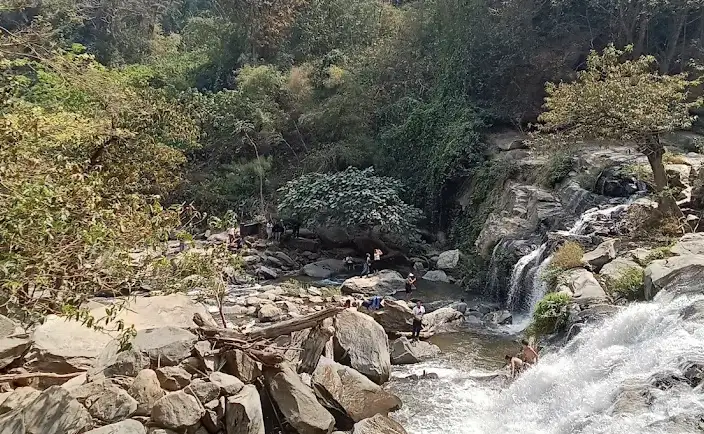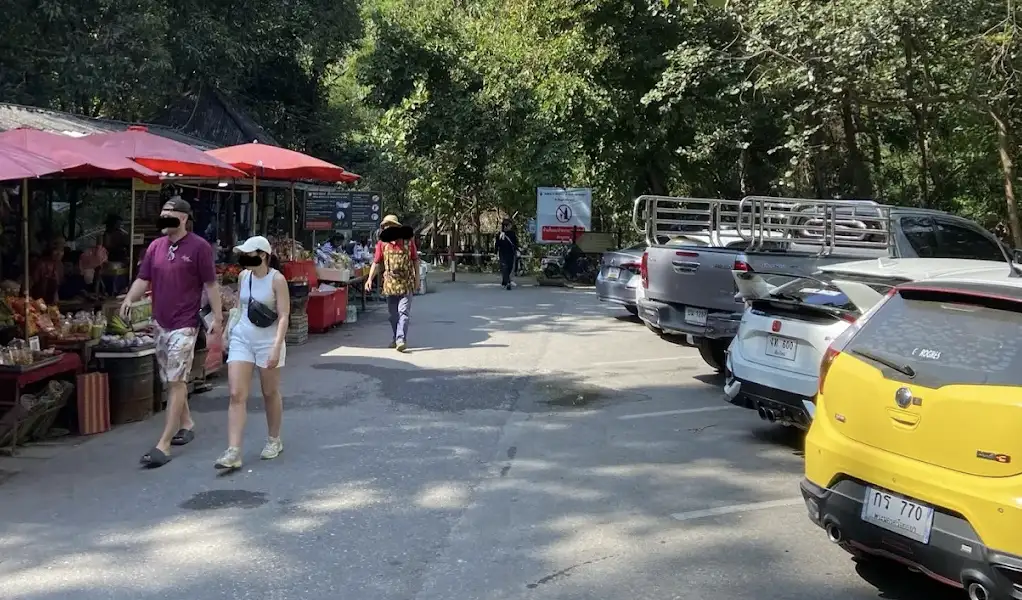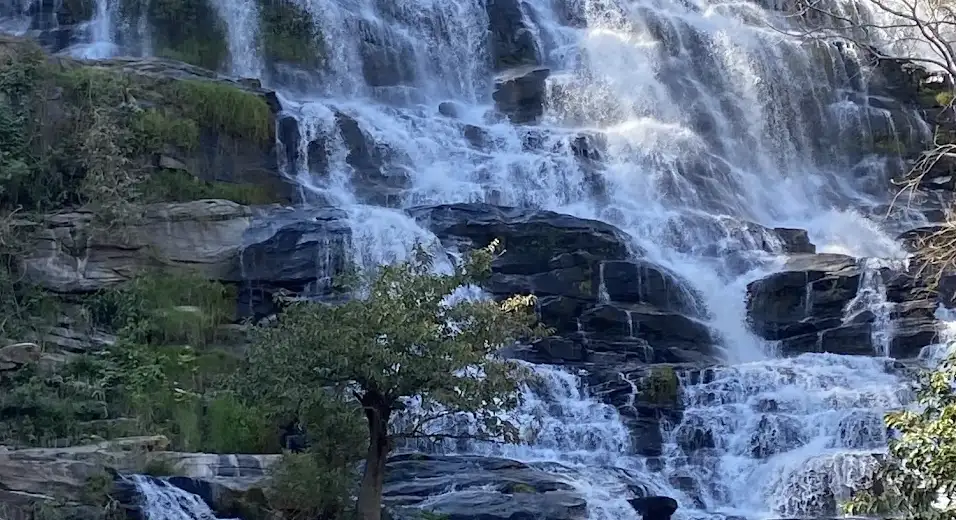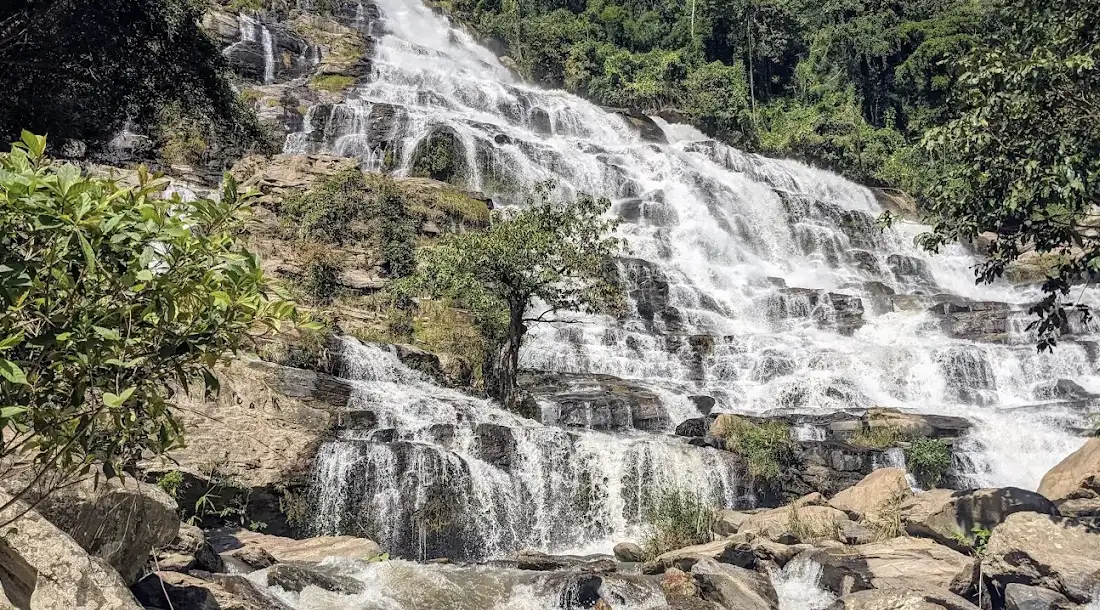Table of Contents
Tucked away in the lush landscapes of Doi Inthanon National Park, Mae Ya Waterfall is a breathtaking spectacle that feels like a reward for those willing to venture off the main tourist trail. Often hailed as one of Thailand’s most beautiful waterfalls, Mae Ya’s towering cascades and serene surroundings left me speechless during my recent visit. This detailed review shares my personal experience, practical tips, and why this waterfall is a must-see, all from the perspective of a traveler captivated by its charm.
Getting There: The Adventure Begins
Mae Ya Waterfall is located in the Chom Thong District, about 60 km southwest of Chiang Mai, within Doi Inthanon National Park but accessible via a separate entrance south of the main park gates. The drive from Chiang Mai city took me about 2 hours on a rented motorbike (300 THB/day, roughly $9 USD), following Highway 108 to Route 1009. The road is mostly well-paved, but the final stretch to the waterfall involves narrow, winding village roads with minimal signage, which added a sense of adventure. I relied on Google Maps, though it led me through a confusing back alley at one point—trust the signs for “Mae Ya Waterfall” when you see them.

For those less keen on navigating, hiring a private driver (1,500-2,000 THB/day) or joining a guided tour (around 1,500 THB/person) is a stress-free option. Public transport like songthaews or Grab cars isn’t practical, as the waterfall is remote, and attractions in the park aren’t walkable from each other. I combined my visit with a Doi Inthanon day trip, which made sense since the park’s entry fee (300 THB/adult, 150 THB/child for foreigners) covers Mae Ya if visited on the same day. Tip: Fill up on gas in Chiang Mai, as stations are sparse near the park.
Arriving at Mae Ya: First Impressions
The parking lot at Mae Ya is modest, with a few food and drink stalls selling snacks like grilled corn (20 THB) and coconut water (30 THB). Toilets here are surprisingly clean, a relief after the long drive. From the car park, it’s a 500-600 meter walk to the waterfall, mostly on a paved path with some sandy and rocky sections toward the end. The trail is easy, with a few steps, taking about 10-15 minutes at a leisurely pace. I wore sneakers, which were perfect for the slightly uneven terrain, and I’d recommend non-slip shoes, especially in the rainy season when paths can get slick.

As I approached, the sound of roaring water grew louder, and then—wow—Mae Ya came into view. The waterfall is massive, cascading down a 30-tiered cliff in a wide, fan-like spread that’s about 100 meters across and up to 260 meters tall, depending on who you ask (some sources claim a more modest 40 meters). The water flows in delicate, curtain-like streams, creating a mesmerizing effect against the lush jungle backdrop. Unlike busier waterfalls like Wachirathan, Mae Ya was blissfully quiet, with only a handful of visitors, giving it an intimate, almost secret feel.
Exploring the Waterfall: A Nature Lover’s Dream
Mae Ya’s sheer size and unique shape make it a photographer’s paradise. I spent ages trying to capture its grandeur, though my phone’s lens struggled to fit the entire waterfall in one frame—a wide-angle lens (24mm or wider) is ideal for pros. The best viewing spots are at the end of the trail, where you can stand close to the base and feel the cool mist. I visited in November, during the cool season, and the water volume was impressive without being overwhelming, perfect for photos and wading.

The pools at the base are inviting for a dip, though signs warn against climbing or swimming in certain areas due to slippery rocks and strong currents. I waded in the shallow sections, where the water was refreshingly cool and clear, but I stayed cautious, as the rocks were slick. For safety, swim with a buddy or under park staff supervision, especially in the rainy season (June-October) when the flow is stronger. I saw a family picnicking under shaded trees along the riverbank, and the area’s picnic tables made it a cozy spot to relax. Bring snacks, as the car park’s food options are limited to light bites.
The surrounding jungle adds to Mae Ya’s allure, with dense greenery and the occasional bird call. I wandered a bit along the river’s edge, spotting small fish darting in the clear water. One reviewer mentioned watching for green snakes near the river (possibly venomous), so I kept an eye out but didn’t see any. The area felt wild yet accessible, with just enough maintenance to keep it safe but not overly polished, which I loved. However, some noted the bamboo bridges and paths could use upkeep, hinting at a slightly neglected charm.
Highlights and Unique Moments
What set Mae Ya apart was its tranquility. Unlike more popular falls in Chiang Mai, I had moments where it felt like my group had the place to ourselves. The waterfall’s delicate, multi-tiered flow reminded me of a natural curtain, and the way it caught the sunlight was almost magical. I climbed a few steps to a higher viewpoint (ignoring a “no climbing” sign at my own risk—don’t recommend it!), and the perspective was even more stunning, though I was careful not to slip.
Another highlight was the sense of discovery. Mae Ya’s off-the-beaten-path location means it’s less advertised, so stumbling upon such a grand waterfall felt like finding a hidden treasure. I chatted with a local vendor at the car park who said Mae Ya is a favorite for Chiang Mai residents looking to escape tourist crowds, which added to its authentic vibe.
Practical Tips for Your Visit
Best Time to Visit: October to March for moderate water flow, clear skies, and cooler weather (15-25°C/59-77°F). November was ideal for me. Rainy season (June-October) brings fuller cascades but slippery paths and stronger currents. Dry season (March-May) may reduce water volume but still offers clear, photogenic pools.
- Getting There: Drive or hire a private car/tour. From Chiang Mai, take Highway 108 for 60 km, turn right onto Route 1009 for 1 km, then left for 14 km to the waterfall. Signs are small, so use GPS or ask locals. No reliable public transport.
- Entrance Fee: Included in Doi Inthanon’s park fee (300 THB/adult, 150 THB/child for foreigners; 50 THB/adult, 20 THB/child for Thais). Same-day park ticket covers Mae Ya.
- What to Bring: Non-slip shoes, swimsuit/towel (if wading), water bottle, snacks, sunscreen, and a wide-angle camera. A light jacket is handy for cool mornings.
- Facilities: Clean toilets at the car park and near the falls, parking, and a few snack stalls. No substantial food, so pack a picnic.
- Safety: Stick to marked paths, avoid climbing restricted areas, and swim cautiously with supervision. Watch for slippery rocks and wildlife like snakes.
- Timing: Arrive early (8-10 AM) for fewer people and better light for photos. Plan 1-2 hours at the waterfall. Combine with Doi Inthanon’s peak or Kew Mae Pan trail for a full day, though Mae Ya is about 40 km from the park’s main sites, so plan travel time.
- Respect the Environment: Don’t litter, follow “no climbing” signs, and avoid disturbing wildlife. Keep the area pristine for others.
Things to Consider
Mae Ya’s remote location can be a challenge. The lack of clear signage and winding village roads made navigation tricky, even with GPS. Some visitors found the 300 THB park fee steep for a single waterfall visit, but I thought it was worth it, especially if paired with other Doi Inthanon attractions. The area’s maintenance could be better—bamboo bridges and paths felt a bit rundown, though it didn’t detract from the experience. Lastly, food options are minimal, so don’t expect a full meal unless you bring your own.
Final Thoughts
Mae Ya Waterfall is a showstopper that lives up to its reputation as one of Chiang Mai’s finest. Its towering, curtain-like cascades, quiet jungle setting, and uncrowded atmosphere made it a highlight of my northern Thailand trip. Compared to busier falls like Mae Sa or Wachirathan, Mae Ya feels like a personal and intimate experience, like you’ve stumbled into nature’s masterpiece. The effort to get there only adds to its allure, making every step of the journey feel worthwhile.
If you’re visiting Chiang Mai or Doi Inthanon, carve out time for Mae Ya. It’s a place to pause, breathe, and let nature’s beauty wash over you. I left with a camera full of photos, wet shoes from wading, and a heart full of awe. I’m already dreaming of returning, maybe in the rainy season to see that 100-meter curtain in full glory. Pack your sense of adventure and go chase this waterfall—you won’t regret it.

